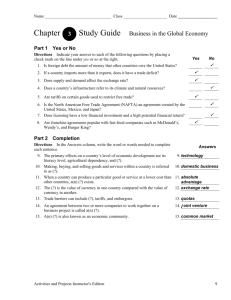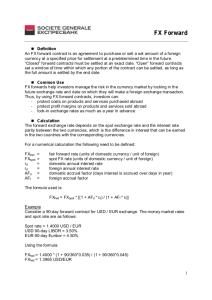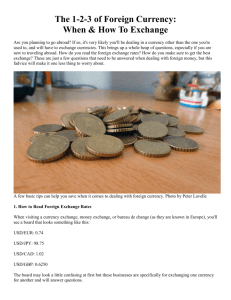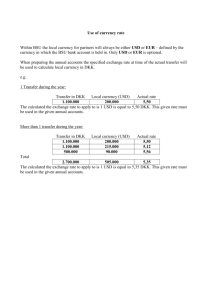Currency of Latin Countries
advertisement
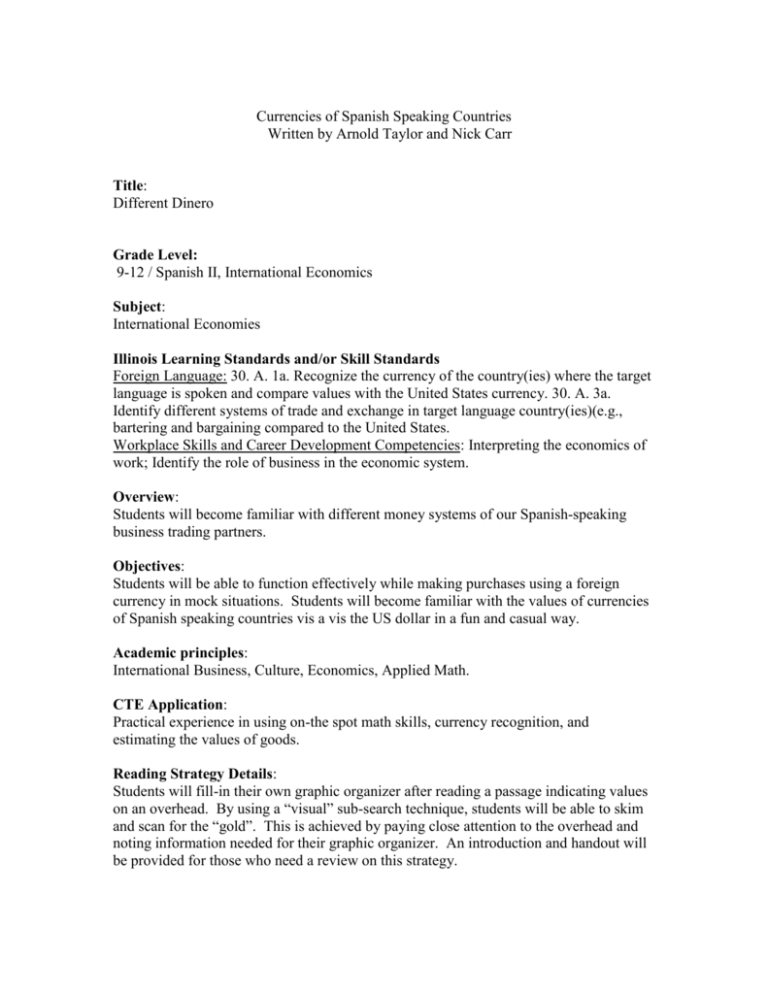
Currencies of Spanish Speaking Countries Written by Arnold Taylor and Nick Carr Title: Different Dinero Grade Level: 9-12 / Spanish II, International Economics Subject: International Economies Illinois Learning Standards and/or Skill Standards Foreign Language: 30. A. 1a. Recognize the currency of the country(ies) where the target language is spoken and compare values with the United States currency. 30. A. 3a. Identify different systems of trade and exchange in target language country(ies)(e.g., bartering and bargaining compared to the United States. Workplace Skills and Career Development Competencies: Interpreting the economics of work; Identify the role of business in the economic system. Overview: Students will become familiar with different money systems of our Spanish-speaking business trading partners. Objectives: Students will be able to function effectively while making purchases using a foreign currency in mock situations. Students will become familiar with the values of currencies of Spanish speaking countries vis a vis the US dollar in a fun and casual way. Academic principles: International Business, Culture, Economics, Applied Math. CTE Application: Practical experience in using on-the spot math skills, currency recognition, and estimating the values of goods. Reading Strategy Details: Students will fill-in their own graphic organizer after reading a passage indicating values on an overhead. By using a “visual” sub-search technique, students will be able to skim and scan for the “gold”. This is achieved by paying close attention to the overhead and noting information needed for their graphic organizer. An introduction and handout will be provided for those who need a review on this strategy. Pre-Activities: Warm-up activity will include a brief introduction to the culture of popular outdoor markets in Latin American countries. Students will discuss how they would make purchases in such an environment. Activities & Procedures: Students will make purchases at a mock store attended by a different group of students at different times, and in different “countries”. Assessment: Formative assessment through direct observation and self-correction. A quiz will be used for self-assessment. Closing & summarization: Students will tell the class what they purchased in (for example) Costa Rica for how many colons. They will also give the value in relation to the US dollar. A review of the graphic organizer and a short quiz will be used to close the lesson. Materials Needed: Copies of currencies from Honduras, Venezuela, Costa Rica, Colombia, Panamá, y Perú. Empty boxes of goods normally purchased at a market, plastic fruit, authentic items from these countries if available, OH projector, transparencies, graphic organizer handout, tables arranged in a u-form, “cash box”, table cloths. Resources: Exito commercial, M. S. Doyle 2001 http://fx.sauder.ubc.ca/currency_table.html http://www.x-rates.com/ http://www.exchangerate.com/ Currencies of Spanish Speaking Countries Techniques for sorting information: Star, Asterisks, Checks Underline Key Points Bracket Major Passages Use any of the symbols to pin point unfamiliar vocabulary. Look for key ideas and underline them. [Brackets are used to emphasize large selections of the text that you think are important to the meaning of the text.] Making Meaning of the Text – Select several tools to help understand the text. Comment in the margins on the vocabulary. Define it or Star, Asterisk, Checks question its meaning. Use listing or bulleting to define the major ideas in a selection of the reading. Number or Bullet a List of Ideas Create your own commonly used short hand words or symbols in the margin of the text. Abbreviate Whenever Possible Make personal connection through shared experience. React Personally Make connections to the topic or focus for the reading. It may be personal, literary, political, or philosophical. Connection Highlight or underline the most essential passages. Make comments in the margins about the highlighted or Highlight the Gold underlined passage. P Paraphrase or Summarize Prediction Write a short summary that explains the main ideas of the reading. Make a prediction about what might come of the ideas considered in the text. If it is a work of fiction, make a prediction about how the story might proceed or end. Mental or visual connections are created much the same way. An example of a Graphic Organizer Handout . . . Moneda/Currency El Colón El Peso Colombiano El Limpira El Quetzal El Sol El Balboa El Dólar Valor (UDS) País/Country Value Cards EL COLÓN= USD EL LEMPIRA= EL SOL= USD EL BALBOA= EL QUETZAL= USD EL PESO= USD USD USD
